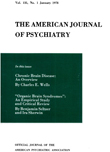CLINICAL AND EEG STUDIES IN OBSESSIVE-COMPULSIVE STATES
Abstract
1. A series of 31 patients presenting as a dominant feature in their clinical picture obsessive-compulsive phenomena were studied clinically and electroencephalographically. Twenty-four of these cases were classifiable as psychoneurotic, obsessive-compulsive type, 2 as epileptic and the remaining 5 as schizophrenia.
2. Twenty of the total of 31 patients, or 64 per cent, exhibited patterns which were classifiable as abnormal. Of these 20 cases 14 showed serial 2-4 cps potentials of high amplitude either before or after a two minutes period of hyperventilation. Approximately 29 per cent of the obsessive-compulsive patients studied exhibited records which were classified as definitely normal.
3. The greatest incidence of records exhibiting electrocortical dysfunction occurred in the age group below 30 years of age.
4. Approximately 35 per cent of the entire group gave definite positive histories of psychopathy in the family. Of the cases showing electrocortical dysfunction 40 per cent gave positive histories while of the patients showing no ERG abnormalities 27 per cent gave positive family histories.
Access content
To read the fulltext, please use one of the options below to sign in or purchase access.- Personal login
- Institutional Login
- Sign in via OpenAthens
- Register for access
-
Please login/register if you wish to pair your device and check access availability.
Not a subscriber?
PsychiatryOnline subscription options offer access to the DSM-5 library, books, journals, CME, and patient resources. This all-in-one virtual library provides psychiatrists and mental health professionals with key resources for diagnosis, treatment, research, and professional development.
Need more help? PsychiatryOnline Customer Service may be reached by emailing [email protected] or by calling 800-368-5777 (in the U.S.) or 703-907-7322 (outside the U.S.).



